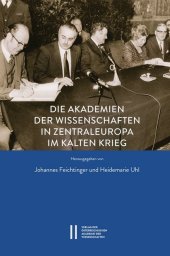 Neuerscheinungen 2018Stand: 2020-02-01 |
Schnellsuche
ISBN/Stichwort/Autor
|
Herderstraße 10
10625 Berlin
Tel.: 030 315 714 16
Fax 030 315 714 14
info@buchspektrum.de |

Johannes Feichtinger, Heidemarie Uhl
(Beteiligte)
Die Akademien der Wissenschaften in Zentraleuropa im Kalten Krieg
Transformationsprozesse im Spanngsfeld von Abgrenzung und Annäherung
2018. 565 S. 65 Abb. 24 cm
Verlag/Jahr: VERLAG DER ÖSTERREICH. AKADEMIE DER WISSENSCHAFTEN 2018
ISBN: 3-7001-8198-1 (3700181981)
Neue ISBN: 978-3-7001-8198-9 (9783700181989)
Preis und Lieferzeit: Bitte klicken
In 2013, the Academy is using the 75th anniversary of the "Anschluss" in March 1938 as an occasion to present an exhibition and to publish a catalog investigating the reactions of the Academy to the Nazi power takeover, the Academy´s involvement in the Nazi domination apparatus, and the impact this had on the postwar period. New research findings allow a profound insight into the personnel and institutional structure of the Academy as well as its scientific focus during the Nazi era.
During the Cold War, the systemic rivalry between East and West was also carried out in the field of scholarship. This volume examines the Academies of Sciences in Central Europe on either side of the Iron Curtain in the early stages of the Cold War (and in some cases beyond). These include academies in the Socialist states (the Slovenian Academy of Sciences and Arts, the Romanian People´s Republic Academy, the Hungarian Academy of Sciences, the Polish Academy of Sciences, the Czechoslovakian Academy of Sciences, and the Slovakian Academy of Sciences), academies in divided Germany (the German Academy of Sciences at Berlin, the Saxon Academy of Sciences, the Bavarian Academy of Sciences and Humanities, the Heidelberg Academy of Sciences and Humanities, and finally the Leopoldina in Halle/Saale as the all-German Academy of Sciences), and the Austrian Academy of Sciences. This volume offers for the first time a comparative perspective on the Central European Academies of Sciences during the Cold War. The overarching focus lies on the one hand on continuities and ruptures within the academies and on the other hand on commonalities and differences between the ´Western´ and Socialist models of the academy. The academies of the Socialist type were soon expanded into comprehensive carriers of science and scholarship, while the ´Western´ academies remained purely societies of scholars. The Austrian Academy of Sciences occupies a middle position between these two models. Many of the findings on the academies of East Central Europe during the Cold War presented in this volume are here made accessible in a Western European language for the first time. The innovative conception of a transnational comparison opens up new scholarly terrain and is intended to offer impulses for further research in the future.


